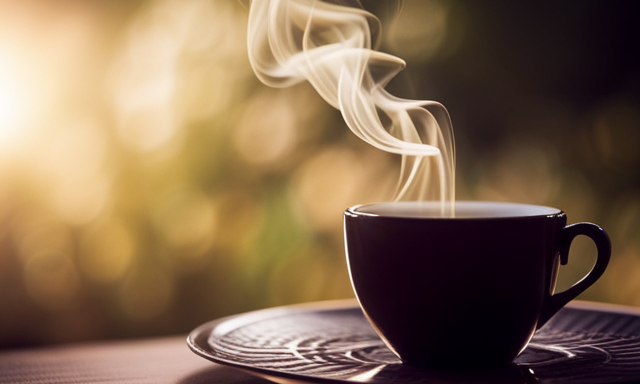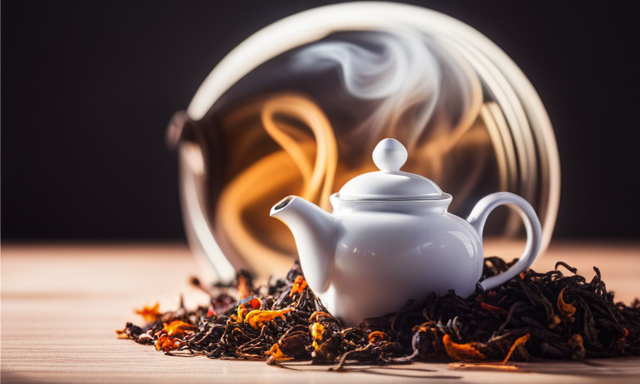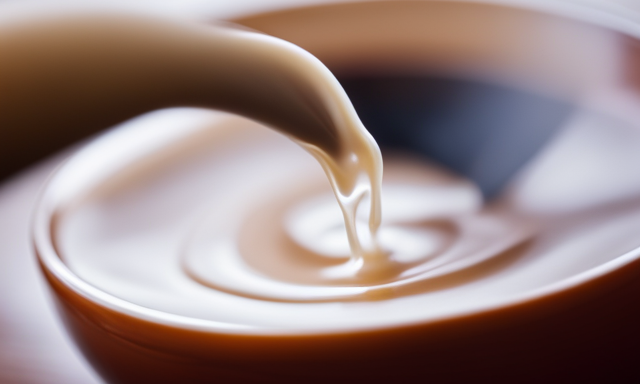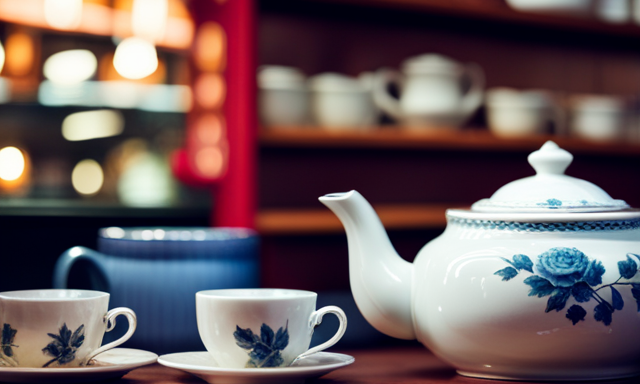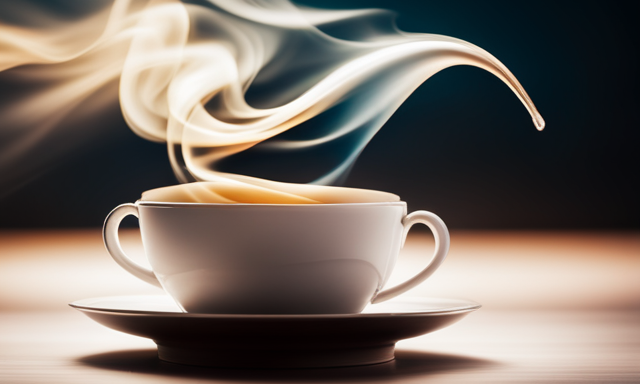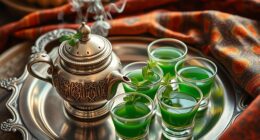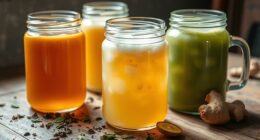Picture this: a cozy afternoon, a steaming cup of tea in hand, and the delicate aroma of oolong tea wafting through the air. There’s something truly special about oolong tea – its rich flavor, its centuries-old history, and its numerous health benefits. But with so many varieties out there, how do you find the best oolong tea for you?
In this article, I will guide you on a journey through the world of oolong tea. We’ll explore its origins and delve into the different varieties, each with its own unique flavor profile.
I’ll also share the incredible health benefits that oolong tea offers, from boosting metabolism to improving heart health. But it doesn’t end there.
I will also reveal the secrets of pairing oolong tea with the perfect foods, creating a symphony of flavors. And to help you on your quest for the best oolong tea, I’ll provide a list of popular brands and sources, along with customer reviews and recommendations.
So, get ready to immerse yourself in the world of oolong tea and discover the best brew that will leave you craving for more.
Key Takeaways
- Oolong tea offers numerous health benefits, including reducing cholesterol levels and decreasing the risk of heart disease.
- Brewing techniques for oolong tea vary depending on the type, with lighter oolongs requiring shorter steeping times and darker oolongs benefiting from longer steeping for rich flavors.
- Oolong tea pairs well with certain foods, such as cheese and dark chocolate, for complementary flavors.
- There are several popular brands and sources for oolong tea, such as Teavana, Adagio Teas, Harney & Sons, and Amazon, where customer reviews and recommendations can provide valuable insights.
Introduction to Oolong Tea
If you’re looking to explore the world of tea, oolong tea is a must-try for its unique and captivating flavors. Oolong tea is a traditional Chinese tea that falls somewhere between green and black tea in terms of oxidation levels. This partially fermented tea undergoes a special processing method that brings out its distinctive characteristics.
Oolong tea is known for its complex flavors, which can range from floral and fruity to toasty and nutty. Not only does oolong tea offer a delightful sensory experience, but it also provides numerous health benefits. It is rich in antioxidants, vitamins, and minerals, and has been linked to improved digestion, weight management, and heart health.
Now, let’s delve into the fascinating history and origins of oolong tea.
The History and Origins of Oolong Tea
Originating in the Fujian province of China, oolong tea is believed to have a rich history dating back many centuries. The history of cultivation of oolong tea is closely tied to Chinese culture and holds great cultural significance.
- Oolong tea has been cultivated in the Fujian province for centuries, with the earliest records dating back to the Tang Dynasty (618-907 AD).
- The unique processing methods used to create oolong tea were developed during the Ming Dynasty (1368-1644). These methods involve withering the leaves, then partially oxidizing them before they are fully dried.
- Oolong tea gained popularity during the Qing Dynasty (1644-1912) and became an important part of Chinese tea culture. It was enjoyed by emperors and scholars, and was even used in traditional Chinese medicine.
With this rich history and cultural significance, it’s no wonder that oolong tea has become a beloved beverage around the world.
In the subsequent section, we will explore the different varieties of oolong tea.
Different Varieties of Oolong Tea
Explore the diverse range of oolong tea varieties, each offering a unique sensory experience and captivating your taste buds with their exquisite flavors and aromas. Oolong tea is produced using different processing methods, resulting in a wide variety of flavors and characteristics. The most common processing methods include withering, oxidation, and roasting. These methods are carefully executed to create oolong tea grades, which range from light and delicate to rich and robust. To give you a better understanding, here is a table showcasing some popular oolong tea varieties and their respective processing methods and grades:
| Variety | Processing Methods | Grade |
|---|---|---|
| Tie Guan Yin | Withering, | Light |
| Oxidation, | ||
| Roasting | ||
| Da Hong Pao | Withering, | Medium |
| Partial Oxidation, | ||
| Roasting | ||
| Oriental Beauty | Withering, | Dark |
| Oxidation, | ||
| No Roasting |
Now that we’ve explored the different varieties of oolong tea, let’s dive into their unique flavor profiles.
The Flavor Profiles of Oolong Tea
When it comes to the flavor profiles of Oolong tea, there are several distinct varieties that offer unique tasting notes.
Floral and perfumed Oolong teas provide a delicate and aromatic experience, with hints of flowers and a smooth, lingering finish.
On the other hand, fruity and citrusy Oolong teas offer a refreshing and tangy flavor, reminiscent of tropical fruits and zesty citrus notes.
Lastly, roasted and nutty Oolong teas boast a rich and toasty taste, with undertones of roasted nuts and a deep, satisfying aftertaste.
Each of these flavor profiles offers a different sensory experience, making Oolong tea a versatile and enjoyable beverage for tea enthusiasts.
Floral and Perfumed Oolong Teas
Indulge in the intoxicating aroma and delicate flavors of floral and perfumed oolong teas, transporting you to a blissful oasis of sensory delight. These teas are a sensory experience like no other, offering a symphony of floral notes and captivating perfumes.
Here are four exquisite options to consider:
-
Jasmine Oolong: The delicate fragrance of jasmine flowers infuses the tea leaves, resulting in a soothing and enchanting brew.
-
Osmanthus Oolong: This tea combines the floral sweetness of osmanthus blossoms with the smoothness of oolong, creating a harmonious blend of flavors.
-
Magnolia Oolong: With its subtle floral aroma, this tea captivates the senses and provides a refreshing and invigorating experience.
-
Rose Oolong: The enchanting scent of roses complements the rich and complex flavors of oolong, creating a truly luxurious tea.
Transitioning into the subsequent section about fruity and citrusy oolong teas, these options offer a refreshing twist on traditional oolong teas.
Fruity and Citrusy Oolong Teas
After exploring the delightful world of floral and perfumed oolong teas, let’s now delve into the realm of fruity and citrusy oolong teas.
These teas offer a refreshing twist with their vibrant flavors and invigorating aromas. Picture yourself sipping a cup of oolong tea that bursts with the sweetness of ripe peaches or the tanginess of tropical oranges. The fruity flavors dance on your palate, combining with the delicate oolong notes to create a truly harmonious experience.
The citrusy aromas uplift your senses, leaving you feeling rejuvenated and energized. Whether you prefer the zesty tang of lemon or the lusciousness of strawberries, there is a fruity and citrusy oolong tea waiting to be discovered.
So, get ready to embark on a tantalizing journey of flavors as we transition into the next section exploring the world of roasted and nutty oolong teas.
Roasted and Nutty Oolong Teas
Immerse yourself in the inviting warmth and rich flavors of roasted and nutty oolong teas. These teas envelop your senses in a comforting embrace, known for their deep, toasty notes and distinct nutty aromas. They create a truly indulgent experience. Here are three reasons why roasted and nutty oolong teas are a must-try:
-
Complex flavor profile: The roasting process brings out the natural sweetness and depth of the tea leaves. This results in a complex flavor profile that is both satisfying and comforting.
-
Aromatic delight: As you sip on a cup of roasted and nutty oolong tea, the delightful aroma of roasted flavors and nutty undertones will transport you to a peaceful oasis. It leaves you feeling relaxed and content.
-
Versatility in brewing: These oolong teas can be brewed in various ways, allowing you to experiment and find your perfect cup. Whether you prefer a shorter infusion for a stronger flavor or a longer steep for a milder taste, the choice is yours.
Now, let’s delve into the health benefits of oolong tea.
The Health Benefits of Oolong Tea
Enhance your well-being by savoring the numerous health benefits of oolong tea.
Not only is it a delicious and refreshing beverage, but it also offers various advantages for your body.
One of the most well-known benefits of oolong tea is its weight loss properties. The combination of caffeine and antioxidants in oolong tea can help boost your metabolism, aiding in the burning of fat.
Additionally, oolong tea has been shown to reduce cholesterol levels. The antioxidants called polyphenols in oolong tea can help prevent the oxidation of LDL cholesterol, ultimately reducing the risk of heart disease.
By incorporating oolong tea into your daily routine, you can support your weight management goals and promote a healthy heart.
Now, let’s dive into the next section and explore the art of brewing techniques for oolong tea.
Brewing Techniques for Oolong Tea
Experience the full flavor and aroma of oolong tea by mastering the art of brewing techniques. To achieve the perfect brew, it is essential to have the right tools at hand. A gaiwan, a Chinese lidded bowl, is commonly used to brew oolong tea. Its wide opening allows the leaves to unfurl and release their flavors fully. Alternatively, a clay teapot can also be used for a more traditional approach.
When it comes to steeping times, oolong tea requires a delicate balance. Depending on the type of oolong tea, the steeping time can range from 1-5 minutes. Lighter oolongs, such as green oolong, generally require shorter steeping times, while darker oolongs, like roasted oolong, benefit from longer steeping to bring out their rich flavors.
Mastering the art of brewing techniques allows you to fully appreciate the nuances of oolong tea. Now, let’s delve into the exciting world of oolong tea and food pairings.
Oolong Tea and Food Pairings
Discover the perfect culinary companions for your oolong tea journey, as delectable flavors intertwine and dance on your taste buds. When it comes to pairing oolong tea with food, the possibilities are endless. The rich and complex flavors of oolong tea make it a versatile beverage that can be enjoyed with a variety of dishes.
To enhance the flavors of oolong tea, consider pairing it with cheese. The creamy and savory notes of cheese complement the floral and fruity undertones of oolong tea. Try pairing a light and floral oolong tea with a mild, soft cheese like Brie or Camembert. For a stronger oolong tea, opt for a sharp and aged cheese like Cheddar or Gouda.
If you have a sweet tooth, indulge in the delightful combination of oolong tea and chocolate. The smooth and rich flavors of chocolate perfectly balance the earthy and nutty taste of oolong tea. Dark chocolate, with its intense flavor, pairs wonderfully with a robust oolong tea. Milk chocolate, on the other hand, complements a lighter oolong tea with its creamy sweetness.
Now that you know the perfect food pairings for oolong tea, let’s explore popular brands and sources for this exquisite beverage.
Popular Brands and Sources for Oolong Tea
When it comes to indulging in the world of oolong tea, you’ll be delighted to find a wide array of popular brands and sources that offer this exquisite beverage. Here are four popular brands and online sources for oolong tea:
-
Teavana: Known for its high-quality teas, Teavana offers a diverse selection of oolong teas sourced from different regions, each with its unique flavor profile.
-
Adagio Teas: With a strong online presence, Adagio Teas offers a wide range of oolong teas, including flavored and traditional varieties, sourced from various countries.
-
Harney & Sons: This family-owned company has been producing exceptional teas since 1983. Their oolong tea collection is highly regarded, featuring blends that cater to different preferences.
-
Amazon: As one of the largest online marketplaces, Amazon provides a convenient platform for purchasing oolong tea from various popular brands and sellers.
Exploring customer reviews and recommendations can further enhance your oolong tea journey, allowing you to discover the perfect blend that suits your taste buds and preferences.
Customer Reviews and Recommendations
Sipping on a cup of oolong tea is like taking a leisurely stroll through a fragrant garden. Customer reviews and recommendations provide a delightful roadmap to finding your perfect blend.
When it comes to oolong tea, customer preferences vary greatly. Some prefer a light and floral flavor, while others enjoy a bold and robust taste. There are oolong teas with hints of fruit, such as peach or citrus, as well as those with more earthy and nutty notes.
Reading customer reviews can give you valuable insights into the different flavors and aromas that each brand offers. Recommendations from fellow tea enthusiasts can guide you towards the best oolong tea that suits your taste buds.
With all this information at your fingertips, you are now ready to delve into the conclusion: finding your perfect oolong tea.
Conclusion: Finding Your Perfect Oolong Tea
Now that you’ve explored the diverse world of oolong tea and gathered insights from customer reviews and recommendations, it’s time to embark on an exciting journey of finding the perfect cup that will truly tantalize your taste buds. When it comes to finding the right brewing method, it’s important to experiment and discover what works best for you. Each oolong tea may require a slightly different approach, so don’t be afraid to adjust the temperature, steeping time, and the amount of tea leaves to find that perfect balance of flavors. To help you navigate through the vast array of options, here’s a handy table that highlights some popular oolong tea flavor profiles:
| Flavor Profile | Description |
|---|---|
| Floral | Delicate, aromatic, and often reminiscent of blooming flowers |
| Fruity | Sweet and refreshing with notes of tropical fruits |
| Roasted | Rich and nutty, with a toasty and earthy flavor |
| Creamy | Smooth and velvety, often with hints of milk or butter |
| Spicy | Bold and invigorating, with a touch of warmth and complexity |
By exploring different flavor profiles, you can truly personalize your oolong tea experience and find the one that suits your preferences perfectly. Happy tea tasting!
Frequently Asked Questions
What are the different grades of oolong tea and how do they affect the taste and quality?
Different oolong tea grades, such as Gao Shan and Tie Guan Yin, impact taste and quality. They require specific brewing methods and equipment to bring out their unique flavor profiles. Some studies suggest oolong tea may aid in weight loss and boost metabolism.
Can oolong tea help with weight loss and metabolism?
Oolong tea can potentially aid in weight loss and boost metabolism. It may help regulate blood sugar levels, promoting fat burning. However, it’s important to note that there can be some potential side effects.
How does the caffeine content in oolong tea compare to other types of tea?
The caffeine content in oolong tea varies depending on the specific tea, but it generally contains less caffeine than black tea and more than green tea. However, the effects of caffeine on sleep patterns can vary from person to person. Additionally, while oolong tea shares some health benefits with green tea, they also have their own unique properties.
Are there any specific brewing methods or equipment recommended for making the best oolong tea?
To make the most exquisite oolong tea, I recommend using specific brewing methods and equipment. Master Oolong tea brewing techniques using specialized equipment designed to enhance the flavors and aromas.
What are some unique or lesser-known flavor profiles of oolong tea that enthusiasts may find interesting?
Some unique flavor profiles of oolong tea include floral notes like orchid or magnolia, fruity undertones like peach or plum, and even roasted or nutty flavors. These lesser-known taste profiles make oolong tea truly fascinating for enthusiasts.
Conclusion
In conclusion, after exploring the rich history, diverse varieties, and health benefits of Oolong tea, it’s evident that finding the best Oolong tea is a delightful journey worth embarking on.
With its exquisite flavors and aromas, Oolong tea offers a sensory experience like no other. From the floral notes of Tie Guan Yin to the toasty flavors of Da Hong Pao, there is a perfect Oolong tea waiting to be discovered by each tea enthusiast.
So, seize the opportunity to indulge in the world of Oolong tea, and let its enchanting taste transport you to a realm of unparalleled bliss.


